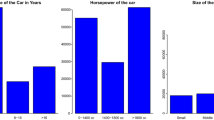Abstract
In this paper we consider statistical problems arising from applications concerning insurance-premium calculation. We describe an integrated set of Bayesian tools for modelling bonus-malus systems (BMS) for insurance premiums. This paper describes a bonus-malus system (BMS) applicable to insurance claims procedures, constructed using a hierarchical Bayesian model. We then address notions and techniques of robust Bayesian analysis in the context of problems arising in BMS.
Similar content being viewed by others
References
Berger, J. O. (1985),Statistical Decision Theory and Bayesian Analysis, Springer-Verlag, New York.
Berger, J. O. (1994). An overview of robust Bayesian analysis (with discussion).Test, 3(1):5–124.
Berger, J. O., Ríos, D., andRucgeri, F. (2000). Bayesian robustness. In D. Ríos and F. Ruggeri, eds.,Robust Bayesian Analysis, pp. 1–32. Springer-Verlag, New York.
Betrò, B., Ruggeri, F., andMęczarski, M. (1994). Robust Bayesian analysis under generalized moments conditions.Journal of Statistical Planning and Inference, 41:257–266.
Bühlmann, H. (1970).Mathematical Methods in Risk Theory, Springer-Verlag, New York.
Eichenauer, J., Lehn, J., andRettig, S. (1988). A gamma-minimax result in credibility theory.Insurance: Mathematics & Economics, 7:49–57.
Frangos, N. andVrontos, S. (2001). Design of optimal bonus-malus systems with a fequency and severity component on an individual basis in automobile insurance.ASTIN Bulletin, 31:1–22.
Gómez, E., Hernández, A., andVázquez-Polo, F. J. (2000). Robust Bayesian premium principles in actuarial science.Journal of the Royal Statistical Society. Series D (The Statistician), 49:241–252.
Gómez, E., Pérez, J. M., Hernández, A, andVázquez-Polo, F. J. (2002). Measuring sensitivity in a bonus-malus system.Insurance: Mathematics & Economics, 31:105–113.
Goovaerts, M. andHoogstad, W. (1987). Credibility theory.Surveys of Actuarial Studies, 4:19–52.
Heilmann, W. (1989). Decision theoretic foundations of credibility theory.Insurance: Mathematics & Economics, 8:77–95.
Klugman, S. (1992).Bayesian Statistics in Acturial Science. Kluwer Academic Publisher, Boston.
Lemaire, J. (1995).Bonus-Malus Systems in Automobile Insurance. Kluwer Academic Publisher, London.
Magalhães, F. andDunsmore, I. R (2003). Predicting the number of accidents at a road junction.Test, 12(1):153–172.
Makov, U. (1995). Loss robustness via Fisher-weighted squared error loss function.Insurance: Mathematics & Economics, 16:1–6.
Martín, J., Ríos, D., andRuggeri, F. (2003). Joint sensitivity in Bayesian decision theory.Test, 12(1):173–194.
Miller, R. B. (1980). Actuarial applications of Bayesian statistics. In A. Zellner, ed.,Bayesian Analysis in Econometrics and Statistics, pp. 197–212. North-Holland, New York.
Ntzoufras, I. andDellaportas, P. (2002). Bayesian modelling of out-standing liabilities incorporating claim count uncertainty.North American Actuarial Journal, 6:113–128.
Ríos, S., Martín, J., Ríos, D. andRuggeri, F. (1999). Bayesian forecasting for accident proneness evaluation.Scandinavian Actuarial Journal, 2:134–156.
Tremblay, L. (1992). Using the Poisson inverse Gaussian in bonus-malus systems.ASTIN Bulletin, 22:97–106.
Winkler, G. (1988). Extreme points of moment sets.Mathematical Operations Research, 13:581–587.
Author information
Authors and Affiliations
Corresponding author
Additional information
Research partially supported by grants from MCyT (Ministerio de Ciencia y Tecnología, Spain, project BEC2001-3774) and DGUI (Dirección General de Universidades e Investigación del Gobierno Autónomo de Canarias, Spain, project PI2003-033).
Rights and permissions
About this article
Cite this article
Gómez-Déniz, E., Vázquez-Polo, F.J. & Pérez, J.M. A note on computing bonus-malus insurance premiums using a hierarchical bayesian framework. Test 15, 345–359 (2006). https://doi.org/10.1007/BF02607056
Received:
Accepted:
Issue Date:
DOI: https://doi.org/10.1007/BF02607056




